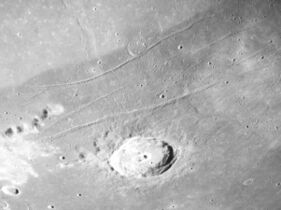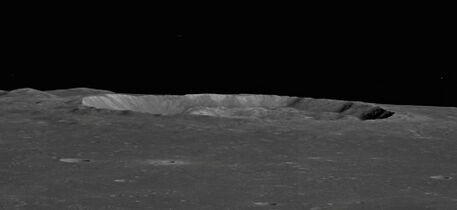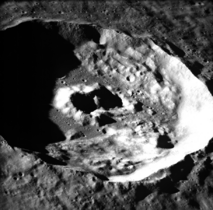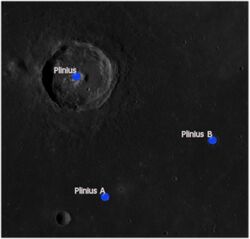Plinius (crater)
Topic: Astronomy
 From HandWiki - Reading time: 3 min
From HandWiki - Reading time: 3 min
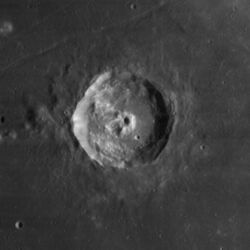 Lunar Orbiter 4 image | |
| Diameter | 41 km |
|---|---|
| Depth | 4.3 km |
| Colongitude | 336° at sunrise |
Plinius is a prominent lunar impact crater on the border between Mare Serenitatis to the north and Mare Tranquilitatis to the south. Its diameter is 41 km. The crater is named after the Roman natural scientist and author Pliny the Elder.[1] To the south-southeast of Plinius is the crater Ross, and to the northeast is Dawes. Just to the north is a system of rilles named the Rimae Plinius and touching it is the Brackett crater which is more than a crater diameter north. At the northwest edge of the rille is the Promontorium Archerusia, a cape off the western rim that encloses the Mare Serenitatis.
Plinius is a crater of Eratosthenian age.[2]
Description
The sharp rim of Plinius is slightly oval in form, with a terraced inner wall and an irregular outer rampart. It lacks a visible ray system. The crater floor is hilly, and in the middle is an irregular central peak that has the appearance of a double crater formation under certain angles of illumination. A cleft feature is attached to the northern side of the peak. The eastern half of the floor is much more smooth and level than the hummocky west, and this section forms a crescent shape about the central peak.
Apollo 15 image at high sun elevation of 71°
Oblique view from Apollo 17 facing south, and showing both Plinius crater and Plinius Rilles
Highly oblique view from Apollo 10, facing northwest.
Satellite craters
By convention, these features are identified on lunar maps by placing the letter on the side of the crater midpoint that is closest to Plinius.
| Plinius | Latitude | Longitude | Diameter |
|---|---|---|---|
| A | 13.0° N | 24.2° E | 4 km |
| B | 14.1° N | 26.2° E | 5 km |
References
- ↑ "Plinius (crater)". Gazetteer of Planetary Nomenclature. USGS Astrogeology Research Program.
- ↑ The geologic history of the Moon. USGS Professional Paper 1348. By Don E. Wilhelms, John F. McCauley, and Newell J. Trask. U.S. Government Printing Office, Washington: 1987. Table 12.2.
- Andersson, L. E.; Whitaker, E. A. (1982). NASA Catalogue of Lunar Nomenclature. NASA RP-1097.
- Bussey, B.; Spudis, P. (2004). The Clementine Atlas of the Moon. New York: Cambridge University Press. ISBN 978-0-521-81528-4.
- Cocks, Elijah E.; Cocks, Josiah C. (1995). Who's Who on the Moon: A Biographical Dictionary of Lunar Nomenclature. Tudor Publishers. ISBN 978-0-936389-27-1. https://archive.org/details/isbn_9780936389271.
- McDowell, Jonathan (July 15, 2007). "Lunar Nomenclature". Jonathan's Space Report. http://host.planet4589.org/astro/lunar/.
- Menzel, D. H.; Minnaert, M.; Levin, B.; Dollfus, A.; Bell, B. (1971). "Report on Lunar Nomenclature by the Working Group of Commission 17 of the IAU". Space Science Reviews 12 (2): 136–186. doi:10.1007/BF00171763. Bibcode: 1971SSRv...12..136M.
- Moore, Patrick (2001). On the Moon. Sterling Publishing Co. ISBN 978-0-304-35469-6. https://archive.org/details/patrickmooreonmo00patr.
- Price, Fred W. (1988). The Moon Observer's Handbook. Cambridge University Press. ISBN 978-0-521-33500-3.
- Rükl, Antonín (1990). Atlas of the Moon. Kalmbach Books. ISBN 978-0-913135-17-4.
- Webb, Rev. T. W. (1962). Celestial Objects for Common Telescopes (6th revised ed.). Dover. ISBN 978-0-486-20917-3. https://archive.org/details/celestialobjects00webb.
- Whitaker, Ewen A. (1999). Mapping and Naming the Moon. Cambridge University Press. ISBN 978-0-521-62248-6.
- Wlasuk, Peter T. (2000). Observing the Moon. Springer. ISBN 978-1-85233-193-1.
External links
Other articles
- Wood, Chuck (December 8, 2009). "Edgy". Lunar Photo of the Day. http://lpod.wikispaces.com/December+8%2C+2009., which include some areas such as Plinius
 |
 KSF
KSF
